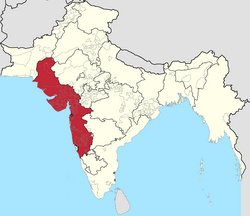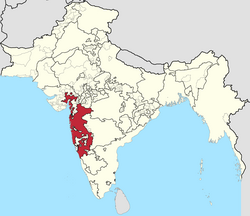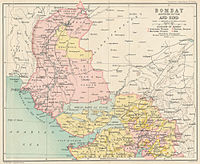
Back বোম্বে প্রেসিডেন্সি Bengali/Bangla Presidència de Bombai Catalan Бомбейн президенталла CE Bombajské prezidentství Czech Bombay (Präsidentschaft) German Presidencia de Bombay Spanish Présidence de Bombay French बंबई प्रेसीडेंसी Hindi Kepresidenan Bombay ID Presidenza di Bombay Italian
This article needs additional citations for verification. (July 2010) |
Presidency of Bombay 1662–1935 Province of Bombay 1935–1950 | |||||||||||||||
|---|---|---|---|---|---|---|---|---|---|---|---|---|---|---|---|
| 1662–1950 | |||||||||||||||
Northern and southern sections of the Bombay Presidency in 1909 | |||||||||||||||
| Capital | Bombay | ||||||||||||||
| Governor | |||||||||||||||
• 1662–1664 (first) | Abraham Shipman | ||||||||||||||
• 1943–1947 (last) | Sir John Colville | ||||||||||||||
| Premier | |||||||||||||||
• 1937–1939 (first) | B. G. Kher | ||||||||||||||
• 1939–1946 | Governor's rule | ||||||||||||||
• 1946–1950 (last) | B. G. Kher | ||||||||||||||
| Historical era | New Imperialism | ||||||||||||||
• Ceded by the Portuguese | 1662 | ||||||||||||||
| 1773 | |||||||||||||||
| 1858 | |||||||||||||||
• Scindia ceded Panchmahal to British | 1861 | ||||||||||||||
• North Canara transferred from Madras | 1862 | ||||||||||||||
• Separation of Aden | 1932 | ||||||||||||||
• Separation of Sind | 1936 | ||||||||||||||
| 1947 | |||||||||||||||
• Bombay Province becomes Bombay State | 1950 | ||||||||||||||
 | |||||||||||||||
| |||||||||||||||
This article incorporates text from a publication now in the public domain: Chisholm, Hugh, ed. (1911). "Bombay Presidency". Encyclopædia Britannica (11th ed.). Cambridge University Press. | |||||||||||||||
| Colonial India | ||||||||||||||
|---|---|---|---|---|---|---|---|---|---|---|---|---|---|---|
 | ||||||||||||||
|
||||||||||||||
|
||||||||||||||
|
||||||||||||||
The Bombay Presidency or Bombay Province, also called Bombay and Sind (1843–1936), was an administrative subdivision (province) of British India and later the Dominion of India, with its capital in the city that came up over the seven islands of Bombay. The first mainland territory was acquired in the Konkan region with the Treaty of Bassein. Poona was the summer capital.[1]
The Bombay province has its beginnings in the city of Bombay that was leased in fee tail to the East India Company, via the Royal Charter of 27 March 1668 by King Charles II of England, who had in turn acquired Bombay on 11 May 1661, through the royal dowry of Catherine Braganza by way of his marriage treaty with the Portuguese princess, daughter of John IV of Portugal. The English East India Company transferred its Western India headquarters from Surat in the Gulf of Cambay after it was sacked, to the relatively safe Bombay Harbour in 1687. The province was brought under Direct rule along with other parts of British India through Pitt's India Act, after the nationalisation of the East India Company. Major territorial acquisitions were made by the company after Anglo-Maratha Wars when the whole of the Peshwa's dominions and much of the Gaekwad's sphere of influence were annexed to the Bombay Presidency in stages up until 1818. Aden including Socotra were placed under Bombay in 1839, Sind was annexed by the company in 1843 after defeating the Talpur dynasty in the Battle of Hyderabad.
At its greatest extent, the Bombay Province comprised the present-day state of Gujarat, the western two-thirds of Maharashtra state, including the divisions of Konkan, Desh & Kandesh, and also northwestern Carnataca; it also included Pakistan's Sindh Province (1847–1935) and Aden of present-day Yemen (1839–1932).[2] The districts and provinces of the presidency were directly under British rule, while the internal administration of the native or princely states was in the hands of local rulers. The presidency, however, managed the defence of princely states and British relations with them through political agencies. The Bombay Presidency along with the Bengal Presidency and Madras Presidency were the three major centres of British power in South Asia.[3]
- ^ Pinney, Christopher (22 November 2004). 'Photos of the Gods': The Printed Image and Political Struggle in India. Reaktion Books. ISBN 9781861891846 – via Google Books.
- ^ Jerry DuPont (2001). The Common Law Abroad: Constitutional and Legal Legacy of the British Empire. Wm. S. Hein Publishing. p. 563. ISBN 978-0-8377-3125-4. Retrieved 15 September 2012.
- ^ Bulliet, Richard W.; Bulliet, Richard; Crossley, Pamela Kyle; Daniel R. Headrick; Steven W. Hirsch; Lyman L. Johnson; David Northrup (1 January 2010). The Earth and Its Peoples: A Global History. Cengage Learning. p. 694. ISBN 978-1-4390-8475-5. Retrieved 16 April 2012.
© MMXXIII Rich X Search. We shall prevail. All rights reserved. Rich X Search





